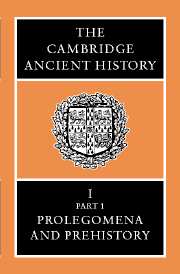Book contents
- Frontmatter
- Contents
- List of Maps
- List of Tables
- List of Text-figures
- Preface
- Chapter I The Geological Ages
- Chapter II Physical Conditions in Eastern Europe, Western Asia and Egypt Before the Period of Agricultural and Urban Settlement
- Chapter III Primitive Man in Egypt, Western Asia and Europe in Palaeolithic Times
- Chapter IV The Evidence of Language
- Chapter V The Earliest Populations of Man in Europe, Western Asia and Northern Africa
- Chapter VI Chronology
- Chapter VII (a) The Earliest Settlements in Western Asia from the Ninth to the End of the Fifth Millennium B.C.
- Chapter VII (b) Anatolia Before 4000 B.C.
- Chapter VIII The Development of Cities From Al-‘Ubaid to the End of Uruk 5
- Chapter IX (a) Predynastic Egypt
- Chapter IX (b) Palestine During the Neolithic and Chalcolithic Periods
- Chapter IX (c) Cyprus in the Neolithic and Chalcolithic Periods
- Chapter X The Stone Age in the Aegean
- Bibliographies
- Index to Maps
- General Index
- Maps
Chapter X - The Stone Age in the Aegean
Published online by Cambridge University Press: 28 March 2008
- Frontmatter
- Contents
- List of Maps
- List of Tables
- List of Text-figures
- Preface
- Chapter I The Geological Ages
- Chapter II Physical Conditions in Eastern Europe, Western Asia and Egypt Before the Period of Agricultural and Urban Settlement
- Chapter III Primitive Man in Egypt, Western Asia and Europe in Palaeolithic Times
- Chapter IV The Evidence of Language
- Chapter V The Earliest Populations of Man in Europe, Western Asia and Northern Africa
- Chapter VI Chronology
- Chapter VII (a) The Earliest Settlements in Western Asia from the Ninth to the End of the Fifth Millennium B.C.
- Chapter VII (b) Anatolia Before 4000 B.C.
- Chapter VIII The Development of Cities From Al-‘Ubaid to the End of Uruk 5
- Chapter IX (a) Predynastic Egypt
- Chapter IX (b) Palestine During the Neolithic and Chalcolithic Periods
- Chapter IX (c) Cyprus in the Neolithic and Chalcolithic Periods
- Chapter X The Stone Age in the Aegean
- Bibliographies
- Index to Maps
- General Index
- Maps
Summary
The existence of a Neolithic culture in the Aegean area was first recognized during the opening years of this century—at Dhimini and Sesklo in Thessaly by Stais and Tsountas, in the regions of Elatea and Chaeronea (in Phocis and Boeotia respectively) by Soteriades, at Boeotian Orchomenus by a Bavarian expedition, at Cnossus in Crete by Evans. Within the first decade the picture of that culture was already filled in in considerable detail and subsequent excavations supplied it with both breadth and depth. But while stone artefacts of pre-Neolithic types were thought to have been found at times on the Greek mainland, no stratified remains surely of Palaeolithic or Mesolithic types were found until 1941, when Stampfuss cut a trench into the fill of the Seidi Cave, located at the south-east corner of the Copaic Basin, about two miles east of Haliartus. Only then was it fairly certain that men in the food-gathering, rather than the food-producing, stage had lived in Greece, but the exact date of these finds remained in question. It was the work of Milojcic and the German expedition to Thessaly which first lengthened enormously the record of human occupation in Greece, with the discovery in 1956 of an Aceramic Neolithic culture at Argissa and then, in 1958, with the location of numerous sites of Middle and Late Palaeolithic occupation along the Peneus River west of Larissa.’ These have been followed by similar discoveries in other parts of the Aegean as well as in Thessaly, and by a re-appraisal of earlier reports, so that a somewhat continuous sequence covering perhaps as much as 100,000 years now begins to take shape.
I. PALAEOLITHIC AND MESOLITHIC
As part of the German expedition to Thessaly, a study of the steep sides and gravel banks of the Peneus River was undertaken in September 1958 by the geologist Dr Dieter Jung. On the first day of his survey Palaeolithic stone artefacts and fossilized bones were found and in rapid succession at least fifteen sites were located along the river in a ten-mile stretch to the west of Larissa; this number grew to well over twenty the following year.
- Type
- Chapter
- Information
- The Cambridge Ancient History , pp. 557 - 618Publisher: Cambridge University PressPrint publication year: 1970



